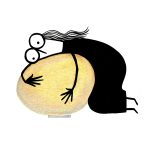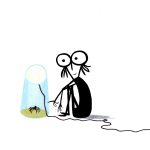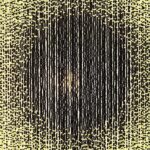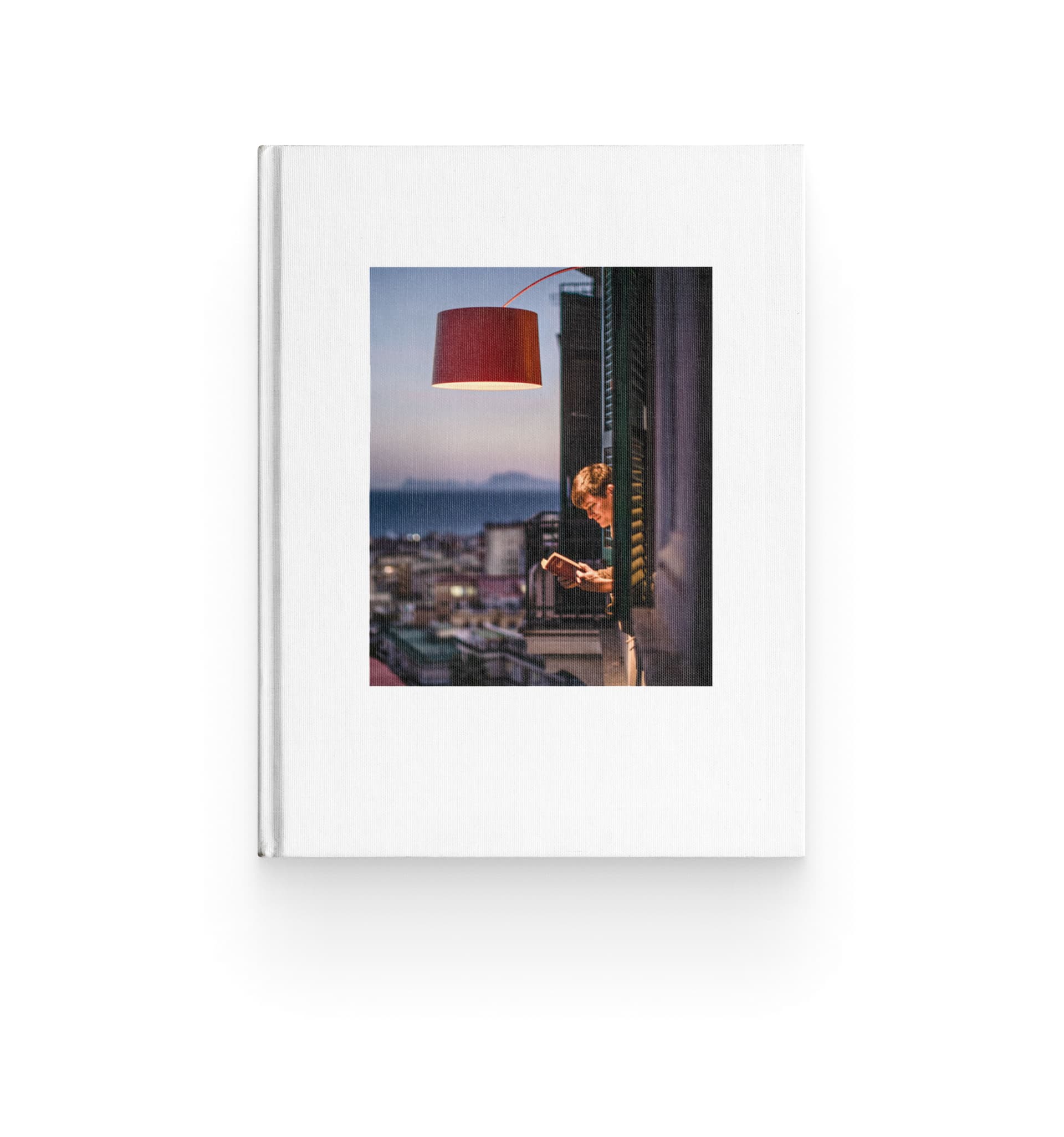Fausto Gilberti’s big-eyed characters meet Foscarini lamps
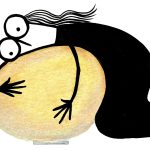
Fausto Gilberti, renowned for his minimalist aesthetic featuring stylized figures with large eyes and slender bodies, unveils a new series within Foscarini’s editorial project “What’s in a Lamp?”.
Fausto Gilberti is a versatile artist—painter, illustrator, and author of books that narrate art, especially contemporary and conceptual art, with irony and curiosity. His distinctive style, teetering between painting and drawing, graphics and illustration, unfolds narratives through images where stylized characters with large eyes emerge against an undefined white background, creating unique yet immediately recognizable scenarios.
His iconic black and white characters navigate an ethereal space, interacting with Foscarini lamps to craft scenarios that are both ironic and surreal. A minimalist and synthetic trait, the result of years of research to find a personal and universal graphic signature representing the human figure reduced to its bare essentials. In this trait, a common thread with the design philosophy of Foscarini lamps comes out clearly: the quest for synthesis, eliminating everything that is superfluous to achieve the essence. Gilberti states: “With drawing, I have always sought simplicity of forms and purity of the sign. I found these formal elements also in Foscarini lamps. In drawing them, I immediately noticed that their shape was in perfect harmony with that of my figures.”
In this exclusive series of drawings, Gilberti’s archetypal little men and women engage with Foscarini’s designer lamp collection—supporting, embracing, and figuratively immersing in their light and form. Offering a unique perspective on the intimate relationship between the individual and light. The black and white illustrations are vibrant and expressive, with subtle details distinguishing the stylized characters, and the lamps—the sole splash of color—contributing to defining the personality of each interacting character. Just as when we choose these lamps for our homes, they become a part of our story.
Follow the “What’s in a Lamp?” project on Instagram to explore the full series and delve into our exclusive interview with artist Fausto Gilberti. Discover his sources of inspiration, artistic journey, and more about this collaboration with Foscarini.
How did your artistic journey begin? Did you always feel that art would be your calling? What was your first significant experience in this world?
As a child, I observed my older brother Mario painting, and I mimicked his actions. Mario, who is much older than me, often took me to exhibitions across Italy and to art cities to admire the works of ancient painters. Even now, his favorite artist remains Beato Angelico above all others.
In 1987, I was a student at art school. During a geometry class, I secretly worked on a drawing depicting hundreds of small figures, completely filling a small sheet of paper. At some point, the teacher noticed my lack of attention. Approaching with an initially threatening manner, he discovered I was drawing. To the surprise of both me and my classmates, instead of scolding me, he exclaimed, ‘Bravo, Gilberti, keep going.’
That specific drawing, titled ‘The Nun,’ showcases 562 little characters, each two and a half centimeters tall, arranged in ten rows. I still have it, and I consider that moment as the beginning of everything.
What drives your creative process? Is it fueled by curiosity, the quest for meaning, or a pursuit of pure visual expression?
I am attracted to all kinds of images, not just artistic ones. Whether they are shared on social media, featured in a glossy magazine, described in literary texts, or brought to life in a movie or evoked through musical experiences—any image that captivates me has the potential to inspire my work.
Your minimalist and synthetic style, with stylized characters featuring big, expressive eyes, has become your trademark. How did you develop this distinctive trait?
It was a slow process of synthesis and reduction of my signature.
As I mentioned, some years ago, I drew detailed human figures. Each little man or woman was different from the others, each with unique characteristics— they were characters. Now, the little figure I draw is the universal representation of humanity reduced to its essentials.
Let’s talk about the project for Foscarini’s “What’s in a Lamp?”. What specifically inspired you in this collaboration? Which piece is your favorite within this project, and what does it mean to you?
In my drawings, I have consistently aimed for simplicity of forms and the purity of the sign. I discovered these formal elements in Foscarini lamps as well. When sketching them, I immediately noticed that their shape was in perfect harmony with that of my figures.
Of all the drawings I created, my favorite is the one featuring the Gregg lamp. I wanted to convey the sweetness, poetry, and elegance of that lamp. The concept of embracing it emerged almost instinctively.
Despite the minimalist style, many of your works effectively convey complete stories, lives, situations, and emotions with just a few strokes. Could you delve deeper into the narrative aspect of your creative process?
Sometimes, a subtle adjustment in the thickness of a line has the power to entirely transform the appearance and meaning of a drawing. Putting marks, shapes, and colors on paper is akin to composing a musical piece—where the notes remain constant, yet you have an infinite possibility of combining them, and a small change transforms the music.
What inspires your work? What aspects of reality captivate you, and how do they influence your artistic style?
I have always had a deep admiration for medieval and early Renaissance painting, and I have always tried to compose my works by drawing inspiration from the formal characteristics of these artistic periods. The symbolism, essentiality, and tranquility of medieval painting; the harmony, balance, and narrative power of the Renaissance. Although I received artistic training in the contemporary art world, I’ve consistently explored and studied diverse creative fields.
Some years ago, one of my main sources of inspiration was music—music videos, album covers, and the imagery associated with certain musical genres. I painted many works on this theme and published a book featuring around 200 drawings.
Cinema has also been a frequent source of inspiration. In 1999, for one of my very first solo exhibitions, I created a series of works (oils on canvas, drawings, and murals) inspired by David Lynch’s Twin Peaks.
I firmly believe that every artist tells their own story; their work is always “autobiographical.” In my work, all the experiences of my life, my passions, as well as my obsessions, find reflection.
You’ve created a series of illustrated books with Corraini Edizioni recounting the lives of diverse artists like Piero Manzoni, Banksy, and Yayoi Kusama. What motivated you to narrate the life and works of other artists, and what is the importance of doing so through the lens of a fellow artist? How does your artistic approach reflect in these biographies?
The first book in the series on contemporary artists happened almost by chance. The idea occurred to me while visiting Piero Manzoni’s exhibition in Milan in 2014. I had brought my two children, Emma and Martino (then 7 and 8 years old), even though I was afraid they might get bored. I observed them wandering around the rooms of Palazzo Reale, intrigued and amused, looking at Manzoni’s bizarre works with astonishment. It was then that I realized my next book would tell a true story — the story of Piero Manzoni.
After publishing the book, I realized that there were other conceptual and revolutionary artists akin to Manzoni, often unfairly prejudiced by adults, who hadn’t been introduced to children. So, with Corraini, we decided to start a dedicated series. I approach these books much like when I draw or paint for an exhibition — with complete freedom and without setting educational or pedagogical objectives. My goal is to have fun and entertain the audience by telling them a story, though complex, in the most minimal and effective way possible, putting considerable effort into synthesizing both the graphic sign and the text.
Who were your mentors or major influences that played a significant role in shaping your artistic vision?
Contemporary artists like Yves Klein, Keith Haring, Jean Dubuffet, Jochum Nordstrom, Raymond Pettibon, and many others. Ancient painters like Rosso Fiorentino, Piero della Francesca, Jan Van Eyck. Writers like Cormac McCarthy and Raymond Carver. Directors like David Lynch and Lars Von Trier. Musicians like Miles Davis, The Cure, Joy Division, Radiohead, Apex Twin, Nine Inch Nails, Bon Iver, Alt-J.
Do you follow a specific ritual or set of habits when you draw?
Let’s say I almost never draw in silence. Instead, I either listen to music or have a movie or TV series playing in the background… and I peek between one pause and another, which is when I lift the brush from the sheet.
What does creativity mean to you?
It is the ability to look at the world and everything within it from multiple perspectives. Seeking what may not be immediately evident to most. And reinterpreting in a personal way what we have discovered and understood.
Follow the project on the official Instagram channel @foscarinilamps


